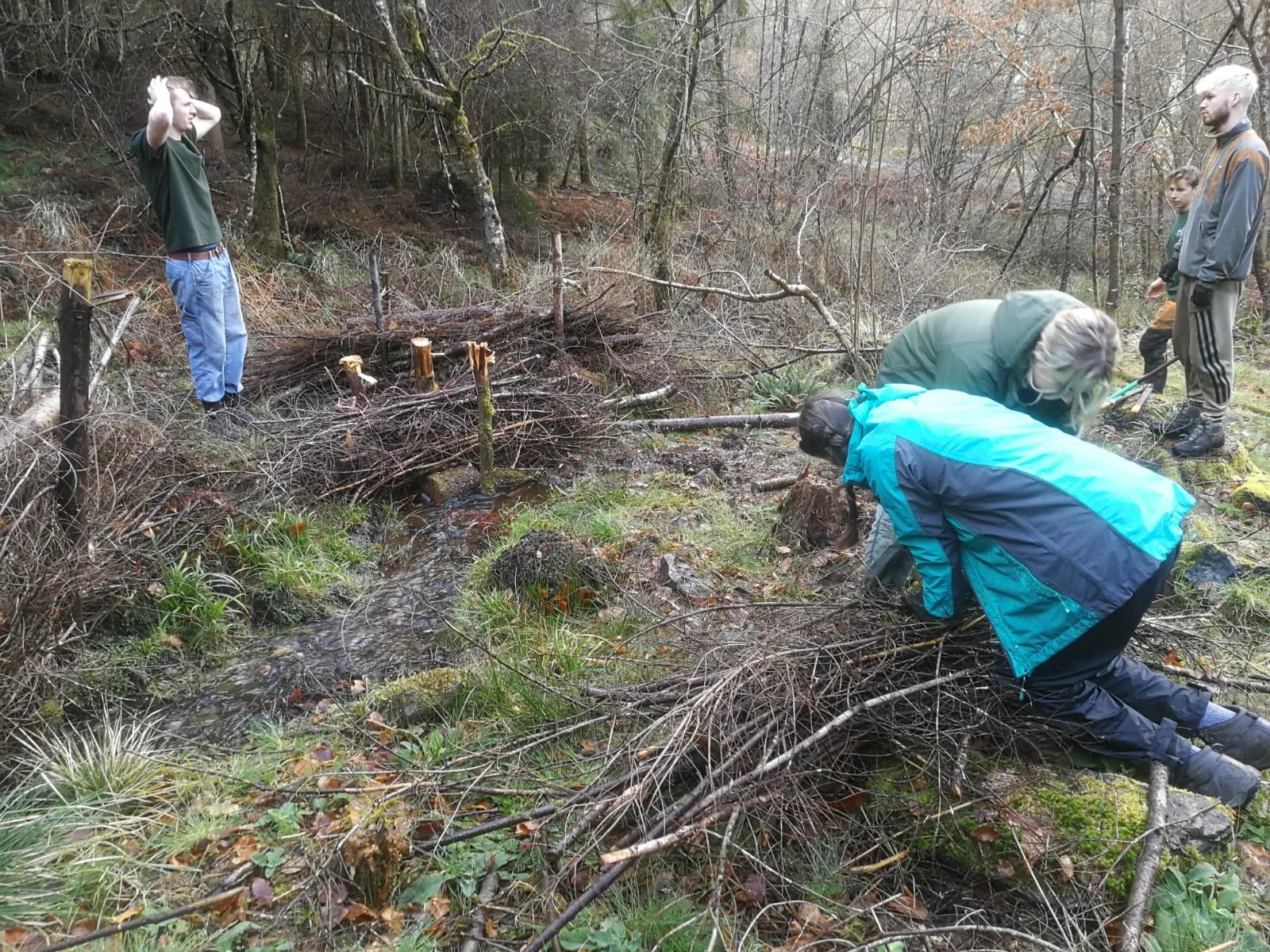Varsity Volunteers
This year the Woodland Trust set up it’s first ‘Varsity Volunteers’ group for students of Exeter and Plymouth Universities, aimed at offering nature conservation opportunities on Dartmoor, meaningful practical work experience and a platform for networking for students. Rosy Stanesby, who attended all of the events has written a blog about her time with the group:
I have had the awesome experience of becoming a Woodland Trust Varsity Volunteer this winter. With a fantastic bunch of people, we have made great changes to our local woodlands with native broadleaf tree restoration, non-native conifer clearing and the creation of natural dams to revert the land to its ancient, wetland nature. The goal: to encourage a thriving, biodiverse woodland ecosystem.
The first event at Bovey Valley Woodlands was in January where we were unexpectedly lucky to have glorious sunshine all day. With Jim and Sam to teach us and barking encouragement from Byron the dog, we planted 100 native broadleaf trees with stakes and tree guards. This was to replace the non-native conifer plantation that was being gradually felled. With this staggered approach, the shock that clear felling has to the soil is reduced. While conifer look magnificent, they have not evolved alongside British flora and fauna and so lack the historical relationships that native species have built together. So, by replacing conifer with native species like oak, hazel, rowan and silver birch, there are more resources available for our local wildlife. The ground was a little rocky in places so it was sometimes challenging to dig a hole for the tree sapling and one alongside it for the stake, but it only made that sense of achievement at the end of the day all the greater.
Planting trees on steep ground
Newly planted trees in protective guards
At the second event, we spent the morning amongst the conifer pulling out the young, regenerating trees. I soon understood why this is important – they completely blanket the woodland floor which blocks out the sun and outcompetes any other tree attempting to grow. As they were so small, they were easy to yank out so this was a hugely satisfying job as we managed to clear a large area quickly. For the larger saplings, we used loppers and for those that had grown into small trees, Sam taught us the step cut technique using bow saws. Working together, we were able to clear some pretty tall conifers and then carry them together to rows where we were piling them up. If there was ever a moment to feel like Chuck Norris, this was it.
We were immensely lucky with the sunshine again, and Phil’s dog Tallie kept Bryon company and us well entertained as they chased each other around. In the afternoon, we removed stakes and tree guards from those that had outgrown them, ready to be reused next year.
Before removal of conifer regeneration
After removal of conifer regeneration
At the third event, we were at Fingle Woods where we spent the morning tree planting. A steep section by the river had recently been clear felled of conifer so we had the job of planting the native trees. This time, we followed the approach of planting densely instead of using tree guards to protect them from deer, meaning we got the job done much faster. We planted around 150 trees in only a few hours. The valley side was immensely steep but miraculously, I managed to avoid the highly probable and hilariously inelegant bum slide!
We had good intentions by commenting on how dry the morning had stayed despite the forecast showers, yet this had clearly jinxed it. We ended our lunch break as drowned rats, which was ironic, as we were then spending the afternoon doing the work of beavers: damming the streams.
To dam the streams, we hammered a couple of posts in to act as the dam barrier. We searched for strong, thick branches and diagonally cut them at one end to produce a point, making it easier to stake them into the ground. Then we collected tree branches into bundles of similar length and tied them tightly together. Because of previous felling, there was plenty of wood lying around. Once dropped in the steam, atop of one another, the wood bundles limited the waterflow, creating pools of water that spilled out around the sides. We repeated this multiple times across two nearby streams, and in only a few hours the area was already transforming into a wetland. We suffered quite a few downpours but the work kept us warm. John was only in his t-shirt!
Making brash dams at Fingle Woods
Brash dams at work - slowing the flow of water
The aim of the dams is to restore the water ways to their ancient, undomesticated behaviours where they meander, pool and flood areas. Not only are these wetland habitats important as they host a huge number of species, they also act as natural flood management strategies by increasing the time taken for rainfall to enter rivers. Therefore, the land holds more water and benefits the surrounding environment.
Unfortunately this was the end to the winter volunteer events, but I am hoping to stay involved in other sessions throughout the year. I jumped at the opportunity to be part of this volunteer group as I am a conservation student and thought it would be a great experience. However, I never expected to love these events so much. I have met awesome people, learnt real, practical skills, and enjoyed every second - not forgetting the highlights - tea and biscuits!
A huge thanks to Rosy for her blog and to all the students who attended. The Varsity Volunteers group will continue throughout the summer at Bovey Valley Woods with wildlife surveying opportunities that include Birds, Bats, Lichens and Butterflies.







